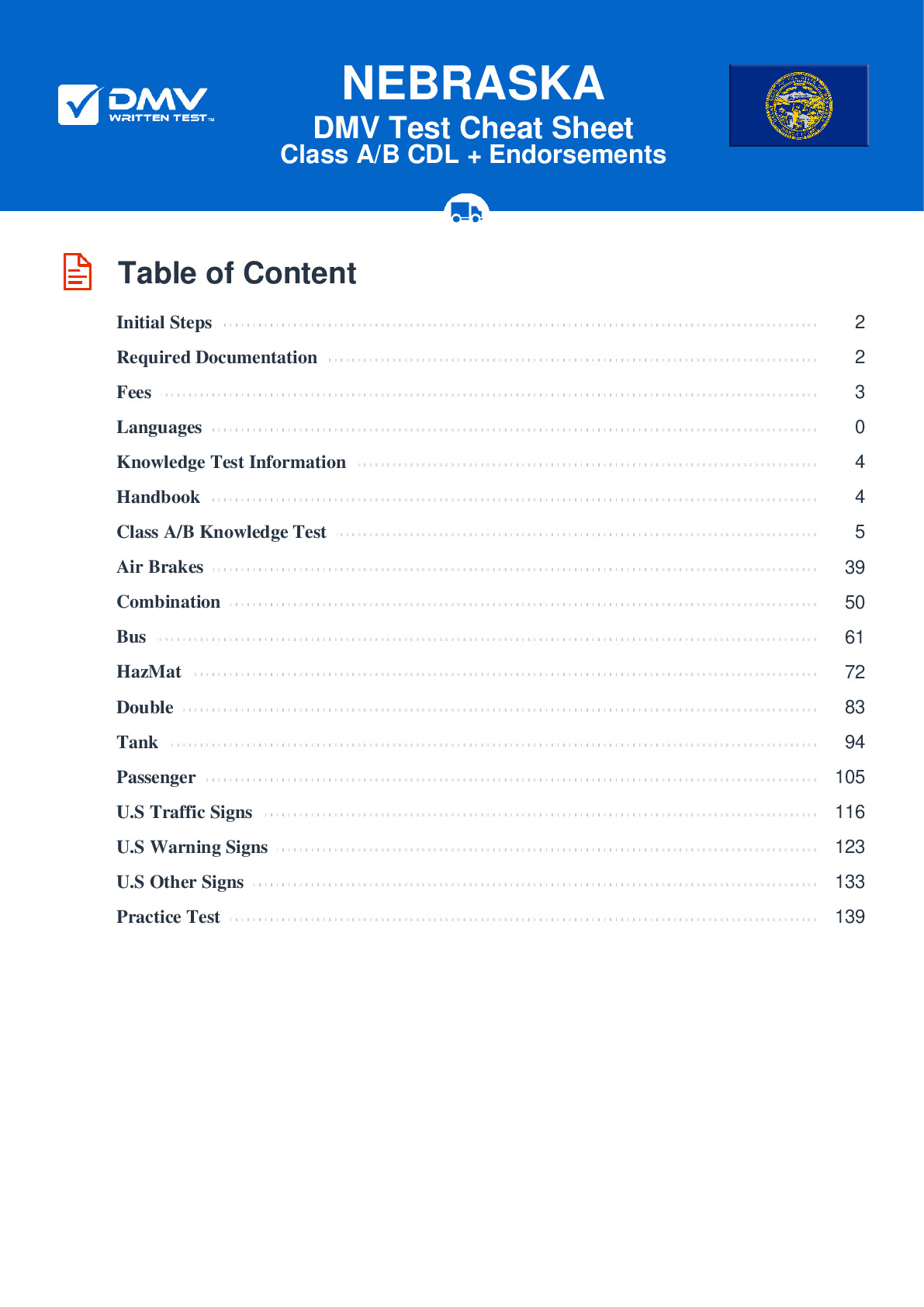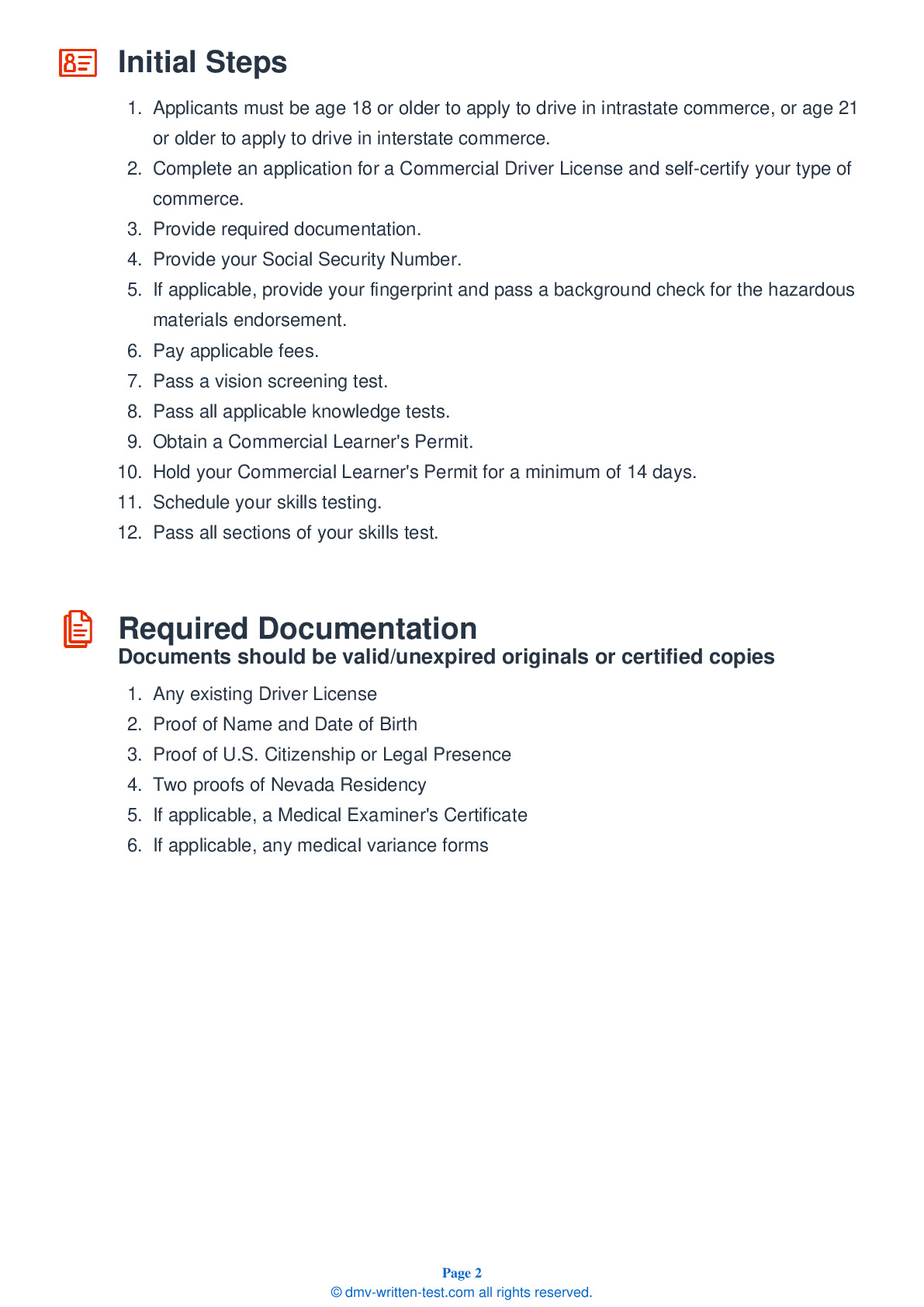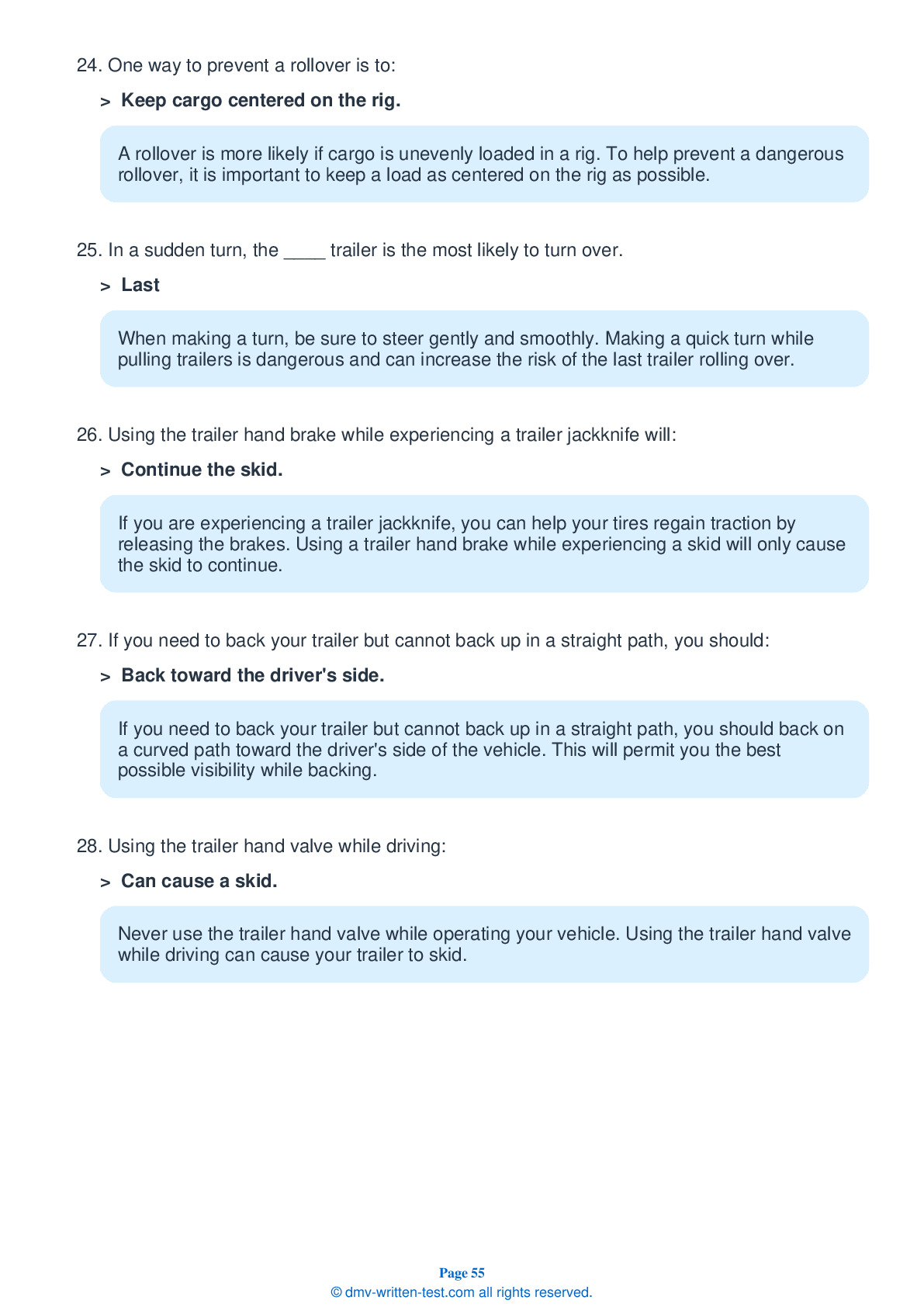Knowledge Test Class B
This license is required for driving a single vehicle with a GVWR of more than 26,001 pounds, and a trailer not to exceed 10,000 pounds gross vehicle weight rating, or a vehicle designed to transport 24 or more people (including the driver). To receive this license, applicants must pass a 50-question test. To pass, applicants must answer 40 questions correctly. Each question has two, three or four possible answer choices. Test questions come from the Nebraska Commercial Driver License Manual. Questions come from chapters covering: Introduction, Driving Safely, Transporting Cargo Safely, Air Brakes (if applicable), Pre-Trip Vehicle Inspection Test, Basic Vehicle Control Skills Test and On-Road Driving.. Endorsements that may be used with a Class B CDL are: Hazardous materials, Tank, Passenger, HazMat and Tank, Air Brakes and School bus.
43. During the driving test, the examiner will be scoring you on:
During the on-road driving test, the examiner will be scoring you on specific driving maneuvers, as well as your general driving behavior.
44. If you plan to transport hazardous materials, you must pass which endorsement test?
You must have a hazardous materials endorsement to drive a vehicle of any size that is used to transport defined classes of hazardous materials.
45. When stopping, the brake pedal:
When stopping, the brake pedal should be pushed down gradually. Control the pressure so your vehicle comes to a slow, safe stop.
46. If you are convicted of a traffic violation:
If you are convicted of any kind of traffic violation, in any type of vehicle, you must notify your employer within 30 days. You must also inform your motor vehicle licensing agency of the violation within 30 days if the conviction happened in another jurisdiction. This rule does not apply to parking infractions.
47. Which of the following is not an indicator of when to change gears?
There are two indicators that determine when you need to shift into a higher gear. One indicator is the engine speed (rpm). You should read your vehicle's manual to learn its rpm range and shift up when you reach the top of that range. The other indicator is road speed (mph). You should learn which speeds each gear can accommodate, then keep an eye on the speedometer and shift up as needed.
48. If air pressure drops to a level between ____, a visual low pressure warning signal should have already activated.
A visual low pressure warning signal should activate before air pressure drops to a level between 55 and 75 psi. This signal could be a light, a buzzer, or a wig wag.
49. Poisonous fumes can enter the cab due to:
Defects in an exhaust system are very dangerous because they can cause poisonous fumes to enter the cab or sleeper berth.
50. Why should the steps of a pre-trip inspection be done in the same order each time?
Pre-trip inspections should be conducted in the same way every time. This will reinforce the steps, making it less likely that you will forget to inspect something important.
Frequently Asked Questions
Here are the steps to obtain a Class B CDL license in Nebraska:
1. Obtain a Nebraska commercial learner's permit (CLP) by passing the written knowledge test at a Nebraska DMV office. The test includes questions about general trucking knowledge and driving safety.
2. Hold the CLP for at least 14 days before taking the skills test.
3. Schedule and pass the skills test, which includes a pre-trip inspection, basic control skills test, and a road test.
4. Provide proof of health certification by passing the DOT medical examination.
5. Submit all required documents and fees to the Nebraska DMV office.
6. Upon passing all tests, receive your Class B CDL license.
It is important to note that in addition to obtaining a CDL license, drivers may need additional endorsements depending on the type of cargo they will be hauling or the type of vehicle they will be operating.
Specifically, vehicles you can operate with a Class B CDL license include:
- Straight trucks (such as delivery trucks, dump trucks, and tow trucks) with a GVWR of 26,001 pounds or more
- Large buses (such as school buses and city transit buses) designed to transport 16 or more passengers
- Segmented buses with a GVWR of 26,001 pounds or more
- Box trucks with attached trailers or vehicles with a total combined weight of less than 26,001 pounds
It is important to note that to operate certain types of vehicles or transport specific types of cargo, additional endorsements may be required.
1. Be at least 18 years of age.
2. Hold a valid Nebraska driver's license.
3. Obtain a commercial learner's permit (CLP) by passing the written knowledge test at a Nebraska DMV office.
4. Hold the CLP for at least 14 days before taking the skills test.
5. Pass the skills test, which includes a pre-trip inspection, basic control skills test, and a road test.
6. Provide proof of health certification by passing the DOT medical examination.
7. Provide proof of residency and legal presence in the United States.
8. Provide your Social Security Number (SSN).
9. Pay all required fees.
It is important to note that additional endorsements may be required depending on the type of vehicle you will be operating and the type of cargo you will be transporting. You must also pass a background check and meet any other requirements set by the Nebraska DMV.
1. Passenger (P) endorsement: required for drivers who will be operating a vehicle designed to transport 16 or more passengers.
2. School bus (S) endorsement: required for drivers who will be operating a school bus.
3. Tank vehicle (N) endorsement: required for drivers who will be operating a tank vehicle with a liquid or gas capacity of more than 119 gallons.
4. Hazardous materials (H) endorsement: required for drivers who will be transporting hazardous materials that require placards.
5. Combination (T) endorsement: required for drivers who will be towing more than one vehicle, such as a trailer or semi-trailer.
It is important to note that each endorsement requires additional knowledge and skills tests, and some endorsements may require a background check or other special requirements.
1. Pre-Trip Inspection: You will be asked to do a thorough inspection of your vehicle, checking all the important parts and systems to ensure they are in good working order.
2. Basic Vehicle Control: You will be asked to demonstrate your ability to control the vehicle in a variety of situations, such as backing up, turning, and parking.
3. Road Test: You will be asked to drive the vehicle on public roads while demonstrating your ability to safely operate the vehicle and follow traffic laws.
During the skills test, you will be evaluated on your ability to perform these tasks safely and effectively. The test is typically administered by a licensed examiner and may take several hours to complete. It is important to study and practice before taking the test to ensure you are fully prepared.
1. Passenger Restrictions: If you have a Class B CDL with a passenger (P) endorsement, you may only operate a vehicle designed to carry 16 or more passengers if you have also completed a passenger transport safety course.
2. Air Brake Restrictions: If you are not licensed to operate vehicles with air brakes, you will have an "L" restriction on your license and will not be authorized to operate vehicles with air brakes.
3. Endorsement Restrictions: You may only operate vehicles for which you have the appropriate endorsements. For example, if you do not have a hazardous materials (H) endorsement, you may not transport hazardous materials.
4. Vehicle Type Restrictions: Your Class B CDL may be restricted to certain types of vehicles. For example, if you take the skills test in a vehicle without air brakes, your license will be restricted to vehicles without air brakes.
It is important to understand and follow all restrictions and limitations that apply to your Class B CDL license to avoid penalties or fines.
However, it is important to note that the skills test must be taken in English. This is because it is essential for drivers to be able to communicate effectively with law enforcement officers and other drivers while operating a commercial vehicle on public roads.
If you need to take the written test in a language other than English, you should contact your local DMV office to confirm which languages are offered and to schedule an appointment for your test. It is also recommended that you study the Nebraska Commercial Driver License Manual in your preferred language before taking the test to ensure you are fully prepared.
Some examples of accommodations that may be available include:
- Providing the test in an alternative format, such as braille or large print.
- Allowing additional time to complete the test.
- Providing a reader or sign language interpreter.
To request accommodations, you should contact the DMV office where you plan to take the test and inform them of your disability and what accommodations you require. You will likely need to provide documentation from a qualified medical professional that verifies your disability and explains how it affects your ability to take the test under standard conditions.
It is important to request accommodations well in advance of your scheduled test date to ensure that they can be arranged in a timely manner.
If you fail the written test three times, you will need to wait at least 14 days before you can take it again. If you fail the test a fourth time, you will need to wait at least 30 days before taking it again.
It is important to note that there is a limit to the number of times you can take the written test. If you fail the test eight times, you will not be allowed to retake it again for a period of six months.
To improve your chances of passing the Class B CDL written test, it is recommended that you study the Nebraska Commercial Driver License Manual thoroughly and take practice tests. You may also want to consider enrolling in a commercial driver training program.




